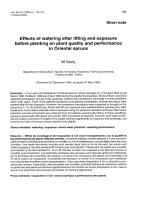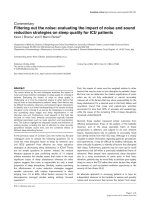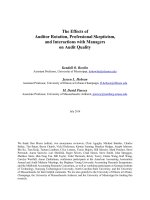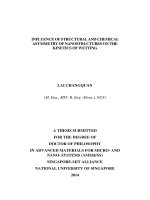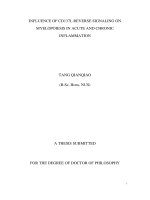Influence of seed grading and specific gravity separator on seed quality parameters of soybean var. DSb-21
Bạn đang xem bản rút gọn của tài liệu. Xem và tải ngay bản đầy đủ của tài liệu tại đây (185.25 KB, 7 trang )
Int.J.Curr.Microbiol.App.Sci (2019) 8(1): 1707-1713
International Journal of Current Microbiology and Applied Sciences
ISSN: 2319-7706 Volume 8 Number 01 (2019)
Journal homepage:
Original Research Article
/>
Influence of Seed Grading and Specific Gravity Separator on Seed Quality
Parameters of Soybean var. DSb-21
Vishwanath, Ravi Hunje*, R. Gurumurthy and M.V. Manjunatha
Department of Seed Science and Technology,
University of Agricultural Sciences, Dharwad-580005, Karnataka, India
*Corresponding author
ABSTRACT
Keywords
Seed recovery,
Soybean var. DSb21, Seed grader,
Specific gravity
separator
Article Info
Accepted:
12 December 2018
Available Online:
10 January 2019
An experiment was carried out at Seed Processing Unit and Seed Quality Testing
Laboratory, Seed Unit, University of Agricultural Sciences, Dharwad, to study the
influence of seed grading and specific gravity separator on seed quality parameters
of soybean var. DSb-21. Among the three sieve size used 3.75 mm recorded
higher recovery (77.60%), seed germination (85.00%) and seedling vigour index
(3293) followed by 4.00 mm (75.20%, 84.33% and 3179, respectively) and 4.80
mm (66.00%, 81.67% and 3016, respectively) over other sieves used under study,
indicating that Seeds obtained from specific gravity separator after processing
through seed grader from below recommended sieve size - 3.75 mm processing
equipment's have great impact upgrading the seed quality.
Introduction
Soybean [Glycine max (L.) Merrill] is a major
oil seed crop of the world grown in India. The
crop is also called as ―Golden Bean‖ or
―Miracle crop‖ of the 21st century on account
of its multiple uses. It has the highest protein
(40 %) and rich oil (20 %), lysine and
vitamins A, B and D. Soybean is one of the
most important economic crop of the world
grown on an area 121.19 million hectares and
production of 336.62 million tonnes with
productivity of 2.78 tonnes per ha (Anon.,
2017). Quality seed plays a vital role in
sustainable agricultural production. The
genetic purity, physical purity, viability,
vigour and uniformity in seed size are
important parameters to determine the quality
of seed. The harvested seed lot contains
impurities, immature and damaged seeds.
Seed size is also positively correlated to seed
vigour.
Uniformity in size and constituents of seed lot
were emphasized for precision sowing as well
as better crop establishment (Bishaw and
Vangastel, 1996). Mechanical seed processing
improves physical purity as well as grade the
1707
Int.J.Curr.Microbiol.App.Sci (2019) 8(1): 1707-1713
seed according to size and specific gravity.
This also improves the test weight,
germination
and
vigour.
Post-harvest
processing machineries and their adjustments
affected seed quality in soybean and most of
the seed crops like chickpea (Sinha et al.,
2009), green gram, black gram, soybean,
sunflower (Bansal and Lohan, 2009). With
advent of new improved varieties and hybrids,
it is advisable to check various seed
processing machines with different screen
sizes to find out its impact on seed recovery
and upgradation in seed lot quality.
The ability of the seed processing in getting
seeds free from inert material, weed seeds and
other species depends largely on the
arrangement, order and choice of the cleaning
and separation equipment used during
processing. Transport equipment (elevators
and conveyor belts) must be well chosen and
dimensioned as it directly affects the quality
of the seeds and may increase the mechanical
damage (Oliveira et al., 1999), may allow or
prevent the occurrence of mechanical mixing
and affect field performance. In general, for
the processing of soybean seeds the following
equipment are used: pre-cleaning machine,
dryer, air-screen machine (cleaning machine),
spiral separator, size grader and gravity
separator.
The size grader is equipment composed of
several flat perforated metal plates with round
holes that sorts seeds by size (width). The
soybean seed varies greatly in size among
different cultivars and within each cultivar.
Uniformity of size in soybean seed allows the
correct adjustment of the plant population in
the field.
The presently recommended sieve size i.e.
4.00 mm for grading soybean seed is based on
old varieties which are out of cultivation in
seed production chain and moreover this sieve
is not matching with any of the high yielding
varieties which are under cultivation. The
sieve size recommended for processing
different crop seeds under the minimum seed
certification standard appear more general and
not appropriate for all the newer varieties
resulting in poor seed recovery.
Gravity separators or gravity separator tables
are equipment widely used in the seed
industry, because they improve the quality by
removing from the batch damaged, diseased,
broken seeds, seeds attacked by insects or
pathogens and other unwanted materials that
are generally lighter than the suitable seeds
(Peske et al., 2012). The gravity separator
removes the seeds of lower density and,
therefore, positively influences the physical
and physiological quality of the seed batch.
The adjustments made to the gravity separator
are loading, lateral and longitudinal
inclinations, air flow, the vibration movement
and fractionation of the load terminal axis.
The seeds of different densities separated
spouts out through the gravity separator output
(Santos-Neto et al., 2012). This study aims to
assess the influence of isolated and
combination of equipment used during the
flow of the processing on the physical and
physiological quality of seed batches of
soybean cultivar. With this objective the
present investigation was carried out.
Materials and Methods
The experiment was conducted to study the
influence of seed grading and specific gravity
separator on seed recovery and quality of
soybean Var. DSb-21 using different sieve
sizes in seed grader and the good seeds
obtained from different size grading were
processed through specific gravity separator at
Seed Processing Unit, Dharwad. The
experiment consisted of following treatments
namely., T1: Seeds obtained from specific
gravity separator after processing through seed
grader from recommended sieve size - 4.00
1708
Int.J.Curr.Microbiol.App.Sci (2019) 8(1): 1707-1713
mm (Heavy), T2: Seeds obtained from specific
gravity separator after processing through seed
grader from recommended sieve size - 4.00
mm (Medium), T3: Seeds obtained from
specific gravity separator after processing
through seed grader from recommended sieve
size - 4.00 mm (Light), T4: Seeds obtained
from specific gravity separator after
processing through seed grader from below
recommended sieve size - 3.75 mm (Heavy),
T5: Seeds obtained from specific gravity
separator after processing through seed grader
from below recommended sieve size - 3.75
mm (Medium), T6: Seeds obtained from
specific gravity separator after processing
through seed grader from below recommended
sieve size - 3.75 mm (Light), T7: Seeds
obtained from specific gravity separator after
processing through seed grader from above
recommended sieve size - 4.80 mm (Heavy),
T8: Seeds obtained from specific gravity
separator after processing through seed grader
from above recommended sieve size - 4.80
mm (Medium), T9: Seeds obtained from
specific gravity separator after processing
through seed grader from above recommended
sieve size - 4.80 mm (Light) and T10:
Unprocessed seeds (Bulk seed) as control
which was laid out in Completely Randomized
Design with three replications. The seeds that
retained on the screen were collected
separately and there quality parameters were
evaluated at Seed Quality and Research
Laboratory, National Seeds Project, University
of Agricultural Sciences, Dharwad during
2017-18.
The Seed germination percentage was worked
out as per the procedure given by ISTA
(Anon., 2011), shoot and root length was
measured in cm, seedling vigour index was
worked out as per the formula given by
Abdul-Baki and Anderson (1973), electrical
conductivity of seed leachate by Presley
(1958) and Physical purity was determined by
procedure given by ISTA (Anon., 2011).
Whereas, the Seed recovery percentage due to
various grading methods were determined by
using the following formula and expressed in
percentage.
Seed recovery (%) =
Weight of seeds obtained after processing
———————————————— 100
Weight of seeds obtained after processing
The data collected in respect of various
parameters on seed quality attributes, were
analyzed statistically as described by Gomez
and Gomez (1984).
Results and Discussion
The seed recovery differed due to seed
grading and specific gravity separator,
significantly higher seed recovery was
recorded in, seeds graded with 3.75 mm sieve
size (77.60 %) which is followed by seeds
graded with 4.00 mm (75.20 %) sieves.
Whereas, in 4.80 mm sieve least seed recovery
per cent was recorded (66.00 %) (Table 1).
The seeds graded with 3.75 mm sieve size
recorded higher seed recovery of 77.60 per
cent compared to seeds graded with 4.00 mm
and 4.80 mm sieve. The reduction in seed
recovery in 4.00 and 4.80 mm may be due to
bold and bigger in seed size than seeds
retained on 3.75 mm sieve and presence of
more amounts of small seeds in seed lot. As
graded good seeds are processed through
specific gravity we will get three fractions and
among them heavy seeds are used for quality
analysis so recovery percent was much less in
this machine combination.
The physical purity differed significantly due
to seed grading and specific gravity separator,
significantly higher physical purity was
recorded in, T4 [seeds graded with 3.75 mm
(heavy) sieve size (99.68 %)] which is on par
with T1 and T7 [seeds graded with 4.00 mm
1709
Int.J.Curr.Microbiol.App.Sci (2019) 8(1): 1707-1713
(heavy) (99.55 %) and 4.80 mm (heavy)
(99.43 %) sieves respectively] whereas, T9
[rejected (light) seed lot of 4.80 mm sieve]
exhibited significantly lower physical purity
(74.42 %) (Table 2). The variation in physical
purity may be due to the removal of shrivelled
seeds, soil particles, other impurities during
processing, which otherwise might not have
been possible during threshing. As good seeds
obtained in seed grader are processed here, the
seed which are heavy has higher physical
purity whereas, more impurities i.e. less
physical purity observed in rejected, medium
and light seed lots. Similar observations of
improved physical purity have been reported
by Ganiger et al., (2016) in greengram and
soybean and Gagare et al., in soybean.
The test weight differed significantly due to
seed grading and specific gravity separator,
significantly higher test weight was recorded
in T4 [seeds graded with 4.80 mm sieve size
(11.16 g) (heavy)] which is followed by [seeds
graded with 4.00 mm (heavy) (10.63 g)
sieves] whereas, T6 [rejected (light) seed lot of
3.75 mm (heavy)] sieve exhibited significantly
lower test weight (9.1 g) (Table 2). The test
weight differed significantly due to seed
grading and specific gravity separator. The
higher test weight in T6 [seeds graded with
4.80 mm sieve size (11.16 g)] might be due to
its larger seed size and more reserve food in
seed as compared over rest of treatments. As
good graded seeds are passed through specific
gravity separator it separates or processes
seeds based on weight and specific gravity, so
heavy seeds which collected at first fraction
have higher test weight than collected at next
two fractions (medium and light). As the
screen size increases during grading test
weight increases indicating the positive
association of seed size and seed weight
[Ganiger et al., (2016) in greengram and
Kausal et al., (2008) in soybean]. Significantly
higher germination percentage was recorded
in T4 [seeds graded with 3.75 mm (heavy)
sieve size (85.00 %)] which is on par with T1
[seeds graded with 4.00 mm (heavy) (84.33
%) and 4.80 mm (heavy) (81.67 %) sieves]
whereas, rejected (light) seed lot of 4.80 mm
exhibited lower germination percentage (59.67
%) (Table 2). Variation in germination within
sieve size used may be due to controlled
conditions in germination chamber than
during field emergence. According to Negi et
al., (1998) large seeds had more breaks in
embryonic axis and other important seed parts
than the small seeds had and therefore showed
poor germination and viability. Small seeds
had better germination uniformity and getting
more faster reserves than larger ones to
seedlings in soybean cv. Katul (Rastegar and
Kandi, 2011). Viability per cent also recorded
highest in seeds processed through 3.75 mm
sieve than 4.00 and 4.80 mm which might be
due to smaller seed size and less mechanical
damage. Jose et al., (2016) reported that as
mechanical damage increases the viability and
vigour deceases in soybean.
Table.1 Influence of seed grading and specific gravity separator on seed recovery of soybean
Sieve size (r)
4.00 mm
3.75 mm
4.80 mm
Seed recovery
Good (kg) Rejected (medium) (kg) Rejected (light) (kg) Percentage (%)
376.00
71.00
23.70
75.20
388.00
66.00
26.20
77.60
330.00
74.70
18.50
66.00
1710
Int.J.Curr.Microbiol.App.Sci (2019) 8(1): 1707-1713
Table.2 Influence of seed grading and specific gravity separator on physical purity, test weight, germination, shoot length, root length,
seedling vigour index-I, seedling dry weight and and electrical conductivity of soybean
Treatmen
t
T1
T2
T3
T4
T5
T6
T7
T8
T9
T10
Mean
S. Em. ±
C. D. @ 1
%
Physical
Test
purity (%) weight
(g)
99.55
10.63
94.35
9.79
82.29
9.21
99.68
10.39
94.69
9.81
76.14
99.43
91.44
74.42
94.31
90.63
0.42
1.24
9.10
11.16
9.84
9.00
10.12
9.91
0.07
0.20
Germinat
ion (%)
Shoot
length (cm)
Seedling dry
weight (mg)
Seedling vigour
index-I
18.01
15.68
11.26
18.10
16.06
Root
length
(cm)
19.69
17.43
13.86
20.65
16.65
79.34
69.09
66.93
78.00
68.17
3179
2410
1540
3293
2310
Electrical
conductivity
(dS m-1)
0.793
1.263
1.444
0.780
1.230
84.33
70.67
61.67
85.00
72.67
62.67
81.67
67.33
59.67
77.33
72.30
1.89
5.57
11.72
17.43
15.65
11.26
17.03
15.21
0.10
0.31
14.09
19.51
16.19
13.45
18.71
17.02
0.09
0.27
65.85
80.18
68.27
65.53
69.28
71.06
0.70
2.08
1618
3016
2143
1473
2764
2375
60
177
1.422
0.801
1.276
1.473
0.788
1.127
0.028
0.083
T1: Seeds obtained from specific gravity separator after processing through seed grader from recommended sieve size - 4.00 mm (Heavy)
T2: Seeds obtained from specific gravity separator after processing through seed grader from recommended sieve size - 4.00 mm (Medium)
T3: Seeds obtained from specific gravity separator after processing through seed grader from recommended sieve size - 4.00 mm (Light)
T4: Seeds obtained from specific gravity separator after processing through seed grader from below recommended sieve size - 3.75 mm (Heavy)
T5: Seeds obtained from specific gravity separator after processing through seed grader from below recommended sieve size - 3.75 mm (Medium)
T6: Seeds obtained from specific gravity separator after processing through seed grader from below recommended sieve size - 3.75 mm (Light)
T7: Seeds obtained from specific gravity separator after processing through seed grader from above recommended sieve size - 4.80 mm (Heavy)
T8: Seeds obtained from specific gravity separator after processing through seed grader from above recommended sieve size - 4.80 mm (Medium)
T9: Seeds obtained from specific gravity separator after processing through seed grader from above recommended sieve size - 4.80 mm (Light)
T10: Unprocessed seeds (Bulk seed) control.
1711
Int.J.Curr.Microbiol.App.Sci (2019) 8(1): 1707-1713
Significantly higher shoot length (18.10 cm),
root length (20.42 cm) and seedling vigour
index (3293) was recorded in T4 [seeds
graded with 3.75 mm (heavy) sieve size],
when compared to T9 [rejected (light) seed lot
of 4.80 mm sieve] (11.17 cm, 14.37 cm and
2143, respectively). However T4 was on par
with T1 [seeds graded with 4.00 mm (heavy)
sieves] (Table 2). Significantly higher shoot
length, root length and vigour index in seeds
graded with 3.75 mm sieve size is probably
due to the difference in the rate of growth of
seedlings, wherein the small size (seeds
graded with 3.75 mm sieve size) seeds
required less moisture than the large size
(seeds graded with 4.00 and 4.80 mm sieve
size) seeds and would have completed the
process of imbibition earlier than the large
size seeds (Singh et al., 1972). Thus, the
seeds graded with 3.75 mm sieve size would
have put fourth longer seedlings and higher
germination resulted higher values for vigour
index.
Similarly, the seedling dry weight differed
significantly due to seed grading and specific
gravity separator, significantly higher
seedling dry weight was recorded in T7 [seeds
graded with 4.80 mm (heavy) sieve size
(80.18 mg)] which is on par with T1 [seeds
graded with 4.00 mm (heavy) (79.34 mg)
sieves] whereas, T9 [rejected (light) seed lot of
4.80 mm sieve] exhibited lower seedling dry
weight (65.53 mg) (Table 2). Higher seedling
dry weight in T7 [seeds graded with 4.80 mm
sieve size (80.18 mg)] may be due to the fact
that the large seeds contained in them more
number of cells per cotyledon in the form of
reserve food material and thus had greater
rates of dry matter accumulation and final dry
weights (Guldan and Brun, 1985). Longer et
al., (1986) concluded that the bold size seeds
of two soybean cultivars Mark and Hill had
higher seedling fresh weight accumulation
than ungraded and small size seeds. These
observations are also in confirmation with the
results of Mohanrao (1993) in soybean. The
electrical conductivity differed significantly
due to seed grading and specific gravity
separator, significantly higher electrical
conductivity was recorded in T9 [rejected
(light) seed lot of 4.80 mm sieve (1.473 dS
m-1)] which is on par with T3 [rejected (light)
seed lot of 4.00 mm (1.445 dS m-1)] and (T6)
3.75 mm (light) (1.422 dS m-1) sieves
whereas, T4 [seeds graded with 3.75 mm
(heavy) sieve size] exhibited lower electrical
conductivity (0.780 dS m-1). McDonald
(1999) revealed that seed size may influence
electrical conductivity results because larger
seed leak more electrolytes due to more
mechanical damage than smaller seeds of
equivalent quality [seeds graded with 3.75
mm sieve size], which results in lower
electrical conductivity.
In conclusion, the processing of seed through
seed grader with different sieve size followed
by specific gravity separator during
processing exhibited significant variation in
seed quality. The higher seed germination,
root length, shoot length, seedling vigour
index was observed in seeds processed
through 3.75 mm sieve and also followed by
specific gravity separator compared to all
other treatment combinations.
References
Abdul Baki, A. A. and Anderson, J. D. 1973.
Vigour determination in soybean seed by
multiple criteria. Crop Science. 13: 630633.
Anonymous. 2011. International Rules for Seed
Testing (ISTA). Seed Science and
Technology. 27: 175.
Anonymous. 2017. USDA, Foreign Agricultural
Service of Global Analysis, Washington,
DC, WAP-03-07.
Bansal, N. K. and Lohan, S. K. 2009. Design and
development of an axial flow thresher for
seed crops. Journal of Agricultural
Engineering. 46(1): 1-8.
Bishaw, Z. and Vangastel, A. J. G. 1996.
1712
Int.J.Curr.Microbiol.App.Sci (2019) 8(1): 1707-1713
Components of seed quality. In: Proc. A
train – the trainer’s workshop. Amman,
Jordan. Pp. 289-298.
Gagare, K. 2014. Mechanical damage due to
different threshing and processing methods
and its effect on seed quality of soybean
[Glycine max (L.) Merrill]. (Doctoral
dissertation, Mahatma Phule Krishi
Vidyapeeth, Rahuri.).
Ganiger, B. S., Basavegowda. Lokesh, G. Y. and
Rekha. 2016. Standardization of screen
sizes for Green gram seed processing. The
Bioscan. 11(4): 2379-2381.
Gomez, K. A. and Gomez, Z. A. 1984. Statistical
Procedures for Agricultural Research. A
Wiley International Science Publication,
New York.
Guldan, S. J. and Brun, W. A. 1985. Relationship
of cotyledon cell number and seed
respiration to soybean seed growth. Crop
Science. 25: 85–92.
Jose, M. G., Neves, J. A., Oliveira, H. P., Silva.
Rodrigo, D. G. E., Reis, J. Z. and Antonio,
R. V. 2016. Quality of soybean seeds with
high mechanical damage index after
processing and storage. Revista Brasileira
de Engenharia Agrícola e Ambiental.
20(11): 1025-1030.
Kausal, R. T., Jeughale, G. S., Kakade, S. U. and
Pravitrakar, N. R. 2008. Studies on
optimum sieve size and type of screen for
grading soybean seed. International Journal
of Agricultural Science. 4: 59-62.
Mc Donald, M. B. 1999. Seed deterioration:
Physiology, repair and assessment. Journal
of Seed Science and Technology. 27: 177273.
Mohanrao, A. 1993. Influence of genotypes and
seed size on seed quality, storability and
field performance in soybean [Glycine max
(L.) Merrill]. M. Sc. (Agri.) Thesis,
University of Agricultural Sciences,
Dharwad, Karnataka (India).
Negi, H. C. S., Kant, K. and Verma, M. M. 1988.
Improving germination by grading in
soybeans. Seeds and Farms. 14 (7): 17-19.
Oliveria, A., Sader, R., Krzyzanowski, F. C. and
Danos. 1999. Mecanicosocorridos no
beneficiamento de sementes de soja e suas
relações com a qualidade fisiologica.
Revista Brasileira de Sementes. 21(1): 5966.
Peske, S. T., Villele, F. A. and Menghello, G. E.
2012. Sementes: fundamentos científicos e
tecnológicos. Pelotas: Editora Universitária
/ UFPel. 3.
Rastegar, Z. and Kandi, M. A. S. 2011. The effect
of salinity and seed size on seed reserve
utilization and seedling growth of soybean
[Glycine max (L.) Merrill. International
Journal Agronomy. 2(5): 1-4.
Presley, J. J. 1958. Relations of protoplast
permeability to cotton seed viability and
predisposition of seedling disease. Plant
Disease Report. 42: 5852.
Santos-Neto, A. L., Carvalho, M. L. M., Oliveria,
J. A., Fraga, A. C. and Souza, A. A. 2012.
Use of densimetric table to improve the
quality of commercial castor bean seeds.
Revista Brasileira de Sementes. 34(4): 549555.
Singh, J, N., Tripathi, S. K. and Negi, P. S. 1972.
Note on the effect of seed size on
germination, growth and yield of soybean.
Indian Journal Agricultural Science. 42 (1):
83-89.
Sinha, J. P., Dhaliwal, J. S., Sinha, S. N. 2009.
Effect of machine parameters on threshing
quality for seed crop in chick pea. Journal
of Agricultural Engineering. 46(4): 11-16.
How to cite this article:
Vishwanath, Ravi Hunje, R. Gurumurthy and Manjunatha, M.V. 2019. Influence of Seed
Grading and Specific Gravity Separator on Seed Quality Parameters of Soybean var. DSb-21.
Int.J.Curr.Microbiol.App.Sci. 8(01): 1707-1713. doi: />
1713




